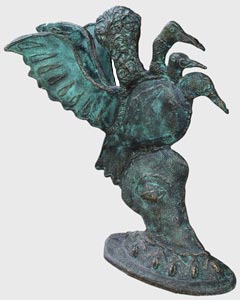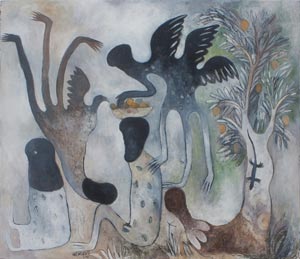Half a century ago, in 1986, the Second Havana Biennial named a jury coming from three continents. It unanimously gave a prize to a piece presented on the last day by Manuel Mendive. A combination of various techniques and ways of art production, so-called body art (painted not only on the bodies of the men and women but also on the ritual animals taking part) prevailed in it, complemented by the rhythmic music, the dance and the scenic staging. With this work, Mendive had once again opened the panorama of Cuban modern art to a new variant: performance as a valid art form.
Mendive starts showing his work at an early age; he makes himself felt during the decade of the 70’s, with pieces worked initially on wood, later on canvas and other traditional media. As Wifredo Lam had done decades before, the young artist feeds his expression with the world close to him; in his case, the rich background of santería, a religious transcultured corpus (in the words of Fernando Ortiz) of African origin with Yoruba roots, and the Catholicism of Spanish colonization. Mendive creates his own pantheon and draws an over-all historical panorama that takes him from the horrors of the Barco negrero (Slave Ship) to the successful uprising of El palenque (Free Town) and the sacrifice of El mambí (a word of possibly African roots applied scornfully by the colonizers to Cuban independence fighters during the 19th century), culminating with the united figures of National Apostle José Martí and Che Guevara in presence of Oyá, the owner of cemeteries. These historical references are insistent themes during some years after Eri Wolé (My head turns around), a complex scene of ample referential context that spells out, so to speak, the accident that Mendive had suffered.
 Water is for Mendive what foliage was for Lam.[i] (I recall the day in a Havana gallery, when Mendive and I chatted, seated on the floor, and I commented about the importance of the presence of water in his painting of the time: he answered that he had never thought of such a thing. I still think it is an important element in his work of that period.) It appears not only in the various paintings specifically centered on the deities (Orishas) linked to the sea and the rivers (Ochún and, above all, Yemayá, that equal the Caridad del Cobre –Cuba's patron saint– and the Virgin of Regla), but also in many other themes (various examples can be found in the lower fringe of El Palenque, a painting that is to be read in an ascendant manner; it is the leading element in El malecón (The seawall), and an ornamental element in various designs in the Telarte projects Mendive took part in during the 80’s). It is a visual representation that suggests the water that surrounds and defines the Island, the water that since old times has signified constant and fluid outcome.
Water is for Mendive what foliage was for Lam.[i] (I recall the day in a Havana gallery, when Mendive and I chatted, seated on the floor, and I commented about the importance of the presence of water in his painting of the time: he answered that he had never thought of such a thing. I still think it is an important element in his work of that period.) It appears not only in the various paintings specifically centered on the deities (Orishas) linked to the sea and the rivers (Ochún and, above all, Yemayá, that equal the Caridad del Cobre –Cuba's patron saint– and the Virgin of Regla), but also in many other themes (various examples can be found in the lower fringe of El Palenque, a painting that is to be read in an ascendant manner; it is the leading element in El malecón (The seawall), and an ornamental element in various designs in the Telarte projects Mendive took part in during the 80’s). It is a visual representation that suggests the water that surrounds and defines the Island, the water that since old times has signified constant and fluid outcome.
After his first period in which he closely illustrates Yoruba mythology, Mendive will create works in which that mythology underlies an illuminating vision of everyday life. His painting will have a wider scope in order to deal with everyday themes that join the mythical elements that had been his more constant elements. Day by day is lived by him in an intense and detailed manner. The sustained presence of contradictory and complementary elements then come to life at the same time. The artist constantly reminds us, in scenes of feasts, dancing, coitus (endokós in Yoruba and title of various series) of the presence of death. It can be depicted as the spirit covered by a huge white cloth that sits on a rocking chair in the middle of a dance or that comes forth in the waters that surround the seawall where lovers are seated. The two-faced figure is also a constant presence in many scenes painted by Mendive. One must remember that Eleguá is one of the more present deities in santería: it opens and closes roads, it refers to laughter and tears, to life and death. This is one of Mendive’s constant reminders; it is one of the ways he has of imbricating a particular mythological symbology to an also particular reality felt by the artist. It is not fortuitous that a formal and thematic change is evident in the artist’s output after the accident that physically marked him: I have already mentioned the painting where actual fact is combined with religious myths.
Since the 80’s and the Biennale’s performance I have mentioned, Mendive has insisted, with variations, on the use of corporal painting used in function of the movements of the dance; some of his creations have been filmed for their repeated viewing. A few years after this activity, Mendive came to be interested in so-called soft sculpture, in which figures of considerable size substitute, with the movements provoked by the mobile structure, the dancers’ movements.
In recent decades, Mendive has produced works that constitute a sort of rich summary of his previous output. Precise contours disappear, as do the sharp colors, the direct allusions and the evident theme matter. Paintings on wood, canvas, soft sculptures, gestural and generic combination in performances join so the imaginative element comes to the fore.
Nowadays, Mendive also works in forms of three dimensions in mixed media, with the use of metals, wood, cloth, canvas, all of which are explored in their possible suggestive projection. The figures that people his works no longer have the precise definition of yesteryear in order to become tenuous beings, with essential elements that suggest a possible interpretation rather than precise boundaries. I wish to point out two elements that are still present for, in a certain way, they are present in elaborations derived from the art production of AfroCuban roots. I am referring to the sustained presence, all through Mendive’s work, of the enlarged feet that take root, so to say, in the earth, and the eyes that, in one or other way, always appear in the faces, the heads, the upper forms of all the figures created by the artist. One must recall that in the corpus of AfroCuban beliefs, the fundamental energy come from the earth; hence the contact with it is essential. In 20th century Cuban painting, this characteristic is very evident in Lam’s initial piece La jungla. But while this element almost immediately disappears from his painting, in Mendive it is an element of constant presence and force. In work made almost half a century ago as well as in current ones, the figures, of evanescent or sharp contours, always touch earth. In more recent productions, they may belong to imaginative, almost moving figures, or may correspond to a more figurative interest: they all touch earth, so pointing out the basic character of this contact.
 As to the eyes, they can also be traced in the production nourished by AfroCuban roots: in Lam, eyes are rhomboidal, repeated to the point of becoming emblematic and have come to be the symbol of several art show summons. In Mendive, the eyes have always been present. In his current production, they can be circles that stand out in the facial space, or can also be a significative dark point that shapes a formless zone. But the «eye that has sight» is always important: it is the contact between the visible and the hidden, the possible unveiling of future situations. It should not be forgotten that the image of the Elegguá, so present in Mendive’s earlier work, is always presented with eyes that look in diverse directions, for it is the deity of the diverse possibilities.
As to the eyes, they can also be traced in the production nourished by AfroCuban roots: in Lam, eyes are rhomboidal, repeated to the point of becoming emblematic and have come to be the symbol of several art show summons. In Mendive, the eyes have always been present. In his current production, they can be circles that stand out in the facial space, or can also be a significative dark point that shapes a formless zone. But the «eye that has sight» is always important: it is the contact between the visible and the hidden, the possible unveiling of future situations. It should not be forgotten that the image of the Elegguá, so present in Mendive’s earlier work, is always presented with eyes that look in diverse directions, for it is the deity of the diverse possibilities.
Mendive’s present imagery tends to offer possible figures of tenuous beings accompanied by sacred animals, all coming forth from a creativity rooted in vital beliefs. Mendive does not seem to feel sharp and excluding cuts. The change from an expressive mode to another all through his work obeys to a unique creative impulse that has dominated him since childhood. There have been, to be sure, some zones of darkness through which light[ii] has always shone forth. Always, since childhood, Mendive has felt the urgency of bringing forth that creative impulse that has led him to so many original and unusual experiences. He will surely follow that road, that is, I’m sure, “very vital”, as is the title of one of his recent sculptures. For the proverbs are not mistaken: “Tree born to be a violin, sounds in the forest”. And Mendive sounds, without doubt, and will continue to do so, for our joy and enrichment.
[i] I remember one day in a gallery of El Vedado in Havana, during which Mendive and I sat on the floor to talk, I told him about of the presence of water in his work of that time; he told me that he had never really thought of such a presence. Manolo, I still affirm that it is a persevering element in your work from that period.
[ii] La Luz y las tinieblas is the title of his exhibition at the Jose Luis Cuevas Museum, in Mexico City, 2011. (Editor’s Note)
Related Publications

How Harumi Yamaguchi invented the modern woman in Japan
March 16, 2022












